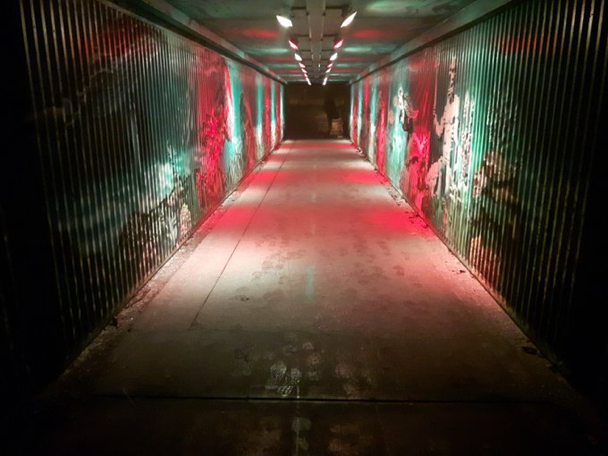The term, liminal, is derived from the Latin word for threshold, limen. Writers often employ the term ‘Crossing the Threshold’ for the moment the hero steps out of their ‘ordinary world’ and enters into the ‘world of adventure’ (Caroline Lawrence, pers comm). A liminal place can be described as a border between two defined spaces. Liminal spaces denote the zones amidst different strata of reality. Liminality can be considered within both physical and abstract contexts. By descending into a trance like condition, shamans. Passage graves and caves, permeable places; places where the living were in close contact with the past, the present, and, perhaps, the future, are considered liminal places. I believe that modern underpasses can also be deemed liminal places.
Edmonds (1995, 70; Van Gennep 2019) proposes that rites of passage involve three distinct stages, separation, liminality, and reincorporation. Separation from the world of everyday associations and the creation of liminal conditions suspends usual conventions and helps contain potential threats. The final stage, that of reincorporation, reconfirms familiar frameworks of order, both social and natural. By descending into the underpass am I heading into the underworld? Will I experience separation, liminality, and reincorporation?
We approach underpasses with trepidation, but we know we must walk their path in order to reach the ‘other side’. Upon entering, I am physically removed from the world above, the world of natural light, the world of the living. I am underground, but I am not. I am moving through and within different spheres. Upon exiting the underpass and returning to the light will I be the same person? Would I have undergone a rite of passage, however small?
The artist, Mark Leckey, upon observing vibrations within concrete environments, has discussed the Stone Tape theory (Leckey, in Wallis & Coustou 2019, 16), where certain buildings, underpasses included, are receptive to the energy produced by traumatic and emotional events. Energies which can be experienced and recorded.
“I had a sense of being propelled into the future while at the same time reversed into the prehistoric past. A past which held an animistic idea of the world, in which rocks and trees could speak” (Leckey, in Wallis & Coustou 2019,16).
Underpasses, elevated walkways, ‘in-between’ concrete places, became congregational points, sub- economies (Penrose 2007, 56). Underpasses bear witness to ritual behaviour; drinking, drugtaking, communal gatherings, initiating feelings of euphoria with the hope of achieving altered states of consciousness, of reality.
Leckey describes how, for him, repetition, or loops, generate energy, power and altered states;
“you enter into a loop that has the potential to take you out of your body into this state of ecstasy but then you yourself are on repeat, you’re stuck. In folklore, the fairies would entrance people into a never-ending dance. A wild delirium that wouldn’t stop until eventually they’d just crumble” (Leckey, in Wallis & Coustou 2019, 15).
Pearson proposed that performance tends towards liminality, challenging and transgressing the relationships, rites, and rituals of everyday life. It is a place where identities may be created, shaped, contested and changed. Where new agendas are set. Whatever passes the boundary and enters the theatrical space is declared significant (Pearson & Shanks2001, 27-8).
I believe that both Leckey’s and Pearson’s ideas apply equally to underpasses. Once within the space the everyday is challenged. The underpass is a place where new identities and agendas can be forged. Where all acts are significant, but also where interactions with forces, both benevolent, and potentially, malevolent, take place. The underpass can be seen as a suspension of disbelief. It is a link between the routine everyday, and the more than human world. One must approach these spaces with caution.
Even as cities are increasingly dominated by functional underground spaces, these zones continue to exert a powerful hold on the imagination. Walking through and within underpasses is, in itself, a process of transition – walking through different spheres to reach the ‘other side’. For Leckey, in returning to the bridge of his youth, he sees that the time he spent there was a “period of transition” (Wallis & Coustou 2019, 35).
We accept that underpasses are an essential element for traversing the landscape, especially within cityscapes, but we do not enjoy moving within them. We do not stroll leisurely through an underpass; they are not the realm of the flâneur. We navigate them as quickly as possible, “they are still repleat with our fears and anxieties about venturing below the surface” (Dobraszczyk 2019, E-Book, Chapter 5).
Underground spaces are full of dark and invisible recesses, they also harbour the potential for subversion. Within underpasses it is dark and often poorly lit. A restricted space, it can often feel claustrophobic, scary, unnerving, but can this also be considered slower, calmer, safer? Can “the very invisibility of underground spaces, their disconnectedness from the world above, lend them an aura of impregnability and security?” (Dobraszczyk 2019, E-Book, Chapter 5). Can the inclusion of art, curvaceous curves, and deviant temptations distract us sufficiently to forget our fears?
BIBLIOGRAPHY:
Dobraszczyk, P., 2019. Future Cities: Architecture and the Imagination. Digital ed. London: Reaktion Books.
Edmonds, M., 1995. Stone Tools and Society: Working Stone in Neolithic and Bronze Age Britain. London: Routledge.
Edmonds, M., 1999. Ancestral Geographies of the Neolithic: Landscapes, Monuments and Memory. London: Routledge.
Penrose, S., 2007. Images of Change: An Archaeology of England’s Contemporary Landscape. Swindon: English Heritage.
Van Gennep, A., 2019. The Rites of Passage. 2nd ed. Chicago, IL: University of Chicago Press.
Wallis, C. & Coustou, E. eds., 2019. In: Mark Leckey: O’ Magic power of Bleakness. London: Tate Publishing.

